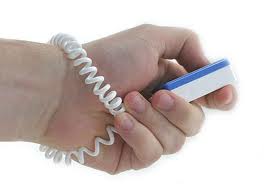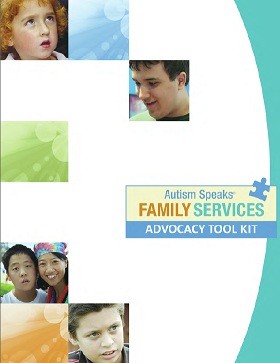TAGteach is all about using a “tagger”
So what exactly is a tagger?
To the right you can see pictures of the two most commonly used taggers.
Taggers are used to “mark” a desired action at the precise moment the child performs it.
The tagger is all about good news
 When you press on the metal plate inside the tagger, it makes a short, sharp sound. The sound is good news! It tells the child he has done something correctly, at the precise instant he performs the action! The follow-up reinforcement tells him that this is a great behavior to perform because he will get more treats and praise.
When you press on the metal plate inside the tagger, it makes a short, sharp sound. The sound is good news! It tells the child he has done something correctly, at the precise instant he performs the action! The follow-up reinforcement tells him that this is a great behavior to perform because he will get more treats and praise.
Wow! Precise, on-time, in-the-moment information for the child and some nice treats to follow-up. Think how great this information and reinforcement is for a kid with autism. This makes it so much easier for the child to focus and learn.
The tagger is easy to use
Kids, both with autism and without, quickly figure out that the tagger is giving them great information and success. Who doesn’t like success? Our kids with autism don’t always have a lot of success, but they love it just as much as anybody else. Taggers make is easy for parents and instructors to deliver lots of success to kids with autism. Isn’t that great? Instead of feeling helpless in the face of difficult behaviors or learning challenges, you can break it down, mark each small step and reinforce your kid’s actions. Instead of feeling like a failure, a kid with autism gets lots of success and praise for what he can do.
The tagger is low-cost
Small plastic taggers/clickers are widely available at stores and via the internet, and come in different shapes, sizes and colors. Prices are low, running from $.89 to $1.50. A pack of 5 TAGteach taggers costs $7.50 on the TAGteach International website. You can see two types of taggers in the pictures above. The taggers on top are known as iClicks; they are smaller and quieter. The taggers on the bottom are standard box taggers. While a tagger is an ideal device, in a pinch, other items can be used, such as ballpoint pens, flashlights, or even hand claps or finger snaps.

Keep it handy!
Taggers are small and easy to drop or misplace. Attach yours to a cord or lanyard and loop it around your belt or wrist. This way, you’ll always know where the tagger is, plus it is easier to find if it is dropped. Have your tagger ready at all times. The treats, or reinforcers, can go into another pocket. With a tagger and treats stowed away, you can be ready in a split second to reinforce desired behaviors.
What about sound sensitivity? Don’t worry.
In the beginning, I worried that the sound of the box tagger might be too loud for my son. He had auditory sensitivity and I didn’t want to aggravate that. If you are worried about that, use the iclick tagger, pictured above; it has a softer sound. If all you have is the box tagger, you can mute the sound by pressing it while it’s in your pocket. The fabric muffles the sound. As it turned out, my son didn’t mind the sound of the tagger at all. He learned very quickly that the tag meant that a treat (reinforcer) was coming, so it quickly became a pleasing sound to him.
The tagger lets you capture those fleeting moments of great behavior
When you have the tagger that is right for your learner, it is easy to mark and reinforce your child for desired behaviors. Even if the behavior only lasts for a split second, you can tag at that exact moment and give your child a treat to their liking. Soon you will see that the behavior you have tagged occurs more often and for longer periods and the undesirable behavior fades away.
What is TAGteach?
TAGteach stands for Teaching with Acoustical Guidance. TAGteach is a teaching and communication method based on the scientific principles of Applied Behavior Analysis (ABA).
TAGteach enables extremely precise positive reinforcement of behavior by using an acoustical signal to “mark” the behavior – at the precise moment the child performs the behavior! The acoustical signal is a short, sharp sound made by a handheld device (the “tagger”). When the child performs the correct action, the parent/instructor immediately presses the button on the tagger and hands over a treat (candy, treat, token, praise, social recognition, or money) as a reinforcer.
With TAGteach, it is easy to reinforce behaviors precisely, quickly, and intensively. The immediate, accurate feedback and positive reinforcement result in the child performing the correct action more often, and for longer periods of time. With immediate feedback and learning tasks broken down into small steps, children (and adults) can learn many new skills with TAGteach — at their own pace.
For more information visit the TAGteach website.
Join the free TAGteach Yahoo Group.
TAGteach taggers are available here.
See Martha’s book about TAGteach for Autism or feel free to ask me a question (with no obligation).
Sign up for my mailing list to receive updates, new articles and free tips right in your inbox!
If you liked this post, please share it. Thank you!
Share the post "Want your child with autism to learn new skills? Here’s everything you need to know about TAGteach taggers."
 A reader posed this question. “What was your first move with your son after you’d learned some concepts and methods? How would you advise families?”
A reader posed this question. “What was your first move with your son after you’d learned some concepts and methods? How would you advise families?”





